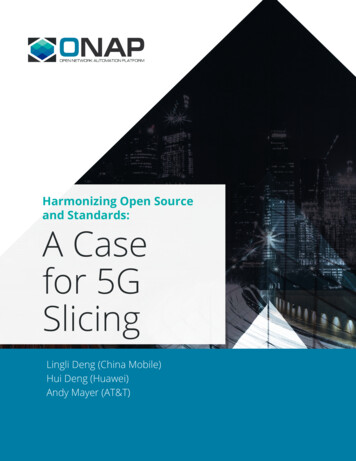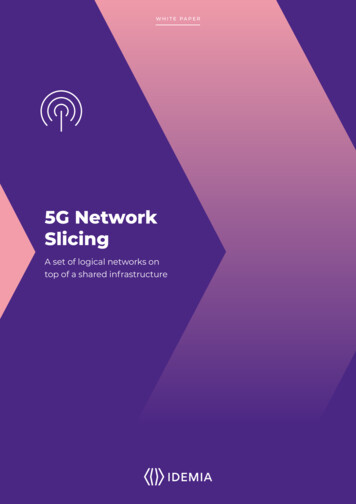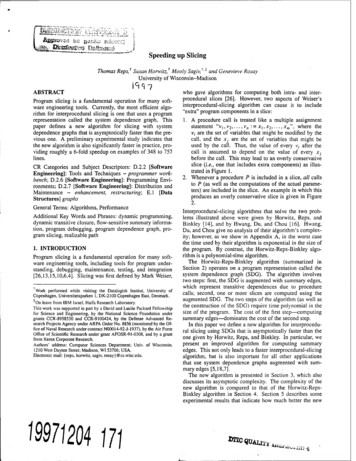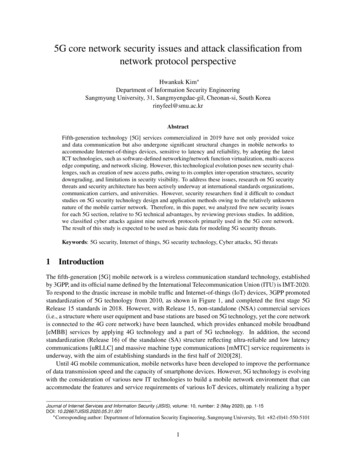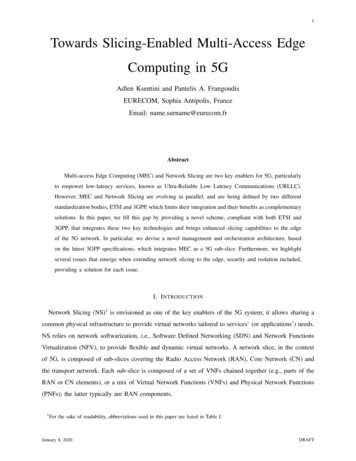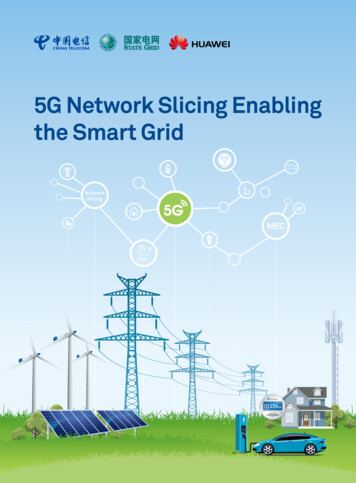
Transcription
5G Network Slicing Enablingthe Smart GridNetworkSlicingMEC
ContentsIntroduction 011 Trends and Challenges of Smart Grid Development 022 Typical Service Scenarios of a 5G Network Slicing Enabled Smart Grid 042.1 Scenario 1: Intelligent Distributed Feeder Automation 042.1.1 Service Scenario 042.1.2 Development Trends and Characteristics 052.1.3 Key Requirements for Communications Networks 062.2 Scenario 2: Millisecond-Level Precise Load Control 062.2.1 Service Scenario 062.2.2 Development Trends and Characteristics 072.2.3 Key Requirements for Communications Networks 072.3 Scenario 3: Information Acquirement of Low Voltage Distribution Systems 082.3.1 Service Scenario 082.3.2 Development Trends and Characteristics 082.3.3 Key Requirements for Communications Networks 092.4 Scenario 4: Distributed Power Supplies 102.4.1 Service Scenario 102.4.2 Development Trends and Characteristics 102.4.3 Key Requirements for Communications Networks 113 5G Network Slicing 123.1 Concepts and Features of 5G Network Slicing 133.2 E2E Architecture of 5G Network Slicing 143.3 Benefits of 5G Network Slicing 154 Discussion on 5G Slicing Solution of the Smart Grid 164.1 Smart Grid Enabled by 5G Network Slicing 174.1.1 Technical Perspective 184.1.2 Service Perspective 184.1.3 Deployment Perspective 184.2 Smart Grid's Multi-Slice Architecture 19
4.3 Life Cycle Management of the Smart Grid 204.3.1 Slice Design on the Smart Grid 204.3.2 Slice Deployment and Enabling on the Smart Grid 204.3.3 Operation of Smart Grid Slices 204.3.4 Slice O&M Monitoring on the Smart Grid 214.3.5 Closed-Loop Optimization of Smart Grid Slices 214.3.6 Slice Capability Exposure on the Smart Grid 225 Conclusion and Outlook 23Figure 2-1 Typical service scenarios of smart grids 04Figure 2-2 Development trends of distribution automation 05Figure 2-3 Key performance indicator (KPI) requirements of intelligent distributed feeder automation forcommunications networks 06Figure 2-4 Development trends of precise load control 07Figure 2-5 KPI requirements of millisecond-level load control for communications networks 08Figure 2-6 Development trends of information acquirement of low voltage distribution systems 09Figure 2-7 K PI requirements of information acquirement of low voltage distribution systems forcommunications networks 09Figure 2-8 Development trends of distributed power supplies 10Figure 2-9 KPI requirements of distributed power supplies for communications networks 11Figure 3-1 E2E architecture of 5G network slicing 15Figure 4-1 Smart grid enabled by 5G network slicing 17Table 4-1 5G network slices meeting various requirements of different Smart Grid scenarios 19Figure 4-2 5G Network slicing architecture of smart grids 19Figure 4-3 Life cycle management of 5G network slices 20Table 4-2 Two types of O&M modes for 5G network slices on the smart grid 21Table 4-3 Two closed-loop optimization modes of 5G network slices on the smart grid 21
5G Network Slicing Enabling the Smart GridIntroductionIntroductionIn recent years, the State Grid Corporation of Chinaexperience and enable vertical industries. In the 5G era,(SGCC) has been building a strong smart grid to improvediversified vertical industry applications will bring morethe security level of the power grid. By implementing theextensive requirements for mobile networks. Ultra-highInternet strategy, the SGCC comprehensively improves thebandwidth, ultra-low latency, and an ultra large numberinformatization and intelligence of the power grid and fullyof connections will change the operating and workingutilizes modern information communication technologiesmodes of core services in vertical industries, improving theand control technologies. This achieves effectiveoperational efficiency and decision-making intelligencesecurity, clean energy, close coordination, and intelligentof traditional vertical industries. Network slicing emergesdevelopment of the power grid and provides reliable powerfrom this background. It provides agile and customizablefor economic and social development. With the rapidcapabilities that allow the construction of dedicateddevelopment of power consumption information collection,networks for different applications.distribution automation, distributed energy access, electricvehicle services, and bidirectional user interaction, theIntelligence technologies represented by artificialcommunication requirements of various power grid devices,intelligence (AI) are driving the fourth industrial revolution.power terminals, and customers are rapidly increasing.Electricity is the blood of industrialization, and networkNew real-time, stable, reliable, and efficient communicationconnections are the nerves. The combination of powertechnologies and systems, suitable for the electric powergrids and 5G networks will provide a solid foundation forindustry, are urgently needed for monitoring the status ofthe intelligent industrial revolution and help "Made inand collecting information about intelligent devices andChina 2025" to achieve its target.triggering new working modes and power service modes.Smart grid is the basis of smart energy and is important014G changes lives, but 5G changes societies. Verticalfor promoting economic and social coordination andindustries represented by power grid will complete digitalsustainable development. It provides strong support fortransformation in the 5G era. "Industry 4.0" of Germanya better life, cleaner environment, and more harmoniousand "Made in China 2025" both require fast networksociety. This helps refine energy management and enablesconnections. 5G networks will bring better bandwidthtransformation to clean energy and electrical energy.
5G Network Slicing Enabling the Smart Grid1 Trends and Challenges of Smart Grid DevelopmentSmart grid is built based on integrated and high-speedbidirectional communications networks. Advancedtechnologies are used to build reliable, secure, economical,efficient, and environment-friendly power grids. Thesetechnologies include sensing, measurement, device, anddecision support system technologies, as well as controlmethods.In May 2009, the SGCC released the concept of a strongsmart grid that features informatization, automation, andinteraction. A strong smart grid uses ultra-high voltagepower grids as backbone networks, while ensuring alllevels of power grids coordinate with these backbonenetworks. The SGCC also specifies its strategic goal anddevelopment route to build a strong smart grid.02
5G Network Slicing Enabling the Smart Grid1 Trends and Challenges of Smart Grid Development1Trends and Challenges of Smart Grid DevelopmentSmart grids are facing new challenges and opportunitiesincreases requirements for available charging capacity.during development and construction.For better demand-side management (DSM) (such aspeak load shaving), new methods can be used to manage New energy: Renewable energy is vital for electricityelectrical power. For example, an electric vehicle cangeneration to cope with global warming and achievecharge when necessary rather than upon connection.sustainable development. The large-scale deployment of 03 New requirements: New devices and new scenariosrenewable energy brings new challenges to the operationrequire higher quality of consumption. For example,and management of power grids. The intermittent andsome high-tech digital devices require zero interruptionrandom power generation of renewable energy bringsof power supplies. In addition, requirements for assetdifficulties to power balancing and operation control.utilization efficiency are gradually increasing from theOn the other hand, the deep penetration of distributedperspective of power grid operation. Such requirementsenergy resources (DER) transforms distribution networksinclude improving device utilization efficiency, reducingfrom passive networks with one-way flows to activethe capacity/load ratio, and reducing line loss. In thisnetworks with bidirectional power flows.case, the load and power supply of power grids must beNew users: The rapid development of electric vehiclesadjusted with more accuracy.
5G Network Slicing Enabling the Smart Grid22 Typical Service Scenarios of a 5G Network Slicing Enabled Smart GridTypical Service Scenarios of a 5G NetworkSlicing Enabled Smart GridFrom the current perspective, a power grid consists of fiveand are likely to be enabled by 5G network slicing in thephases: power generation, transmission, transformation,future. These scenarios include intelligent distributeddistribution, and consumption. Requirements of electricfeeder automation, millisecond-level precise load control,power industry partners are fully surveyed, discussed, andinformation acquirement of low voltage distributionanalyzed. There will be four typical smart grid applicationsystems, and distributed power supplies.scenarios that may require wireless communicationsTypical Service Scenarios of Smart GridsIntelligent distributedfeeder automationMillisecond-levelprecise load controlInformation acquirementof low voltagedistribution systemsDistributedpower suppliesFigure 2-1 Typical service scenarios of smart grids2.1 Scenario 1: Intelligent Distributed Feeder Automation2.1.1 Service Scenario In the first stage, automatic switching devices, which areDistribution Automation is an integrated informationmainly reclosers and sectionalizers, work together, andmanagement system that uses computer technology, datacommunications networks and computer systems aretransmission, control technology, modern equipment, andnot required. If a fault occurs, the automatic switchingmanagement. It is used to improve the reliability of powerdevices isolate the area in which the fault occurred andsupplies and the quality of consumption, provide high-continue supplying power to other areas. During thisquality services to users, reduce operational costs, andstage, automatic reclosers and standby reserved auto-reduce labor intensity. The development of the Distributionswitch-on devices are used, and manual operations areAutomation system can be divided into three stages:still required. These systems are still widely used.04
5G Network Slicing Enabling the Smart Grid2 Typical Service Scenarios of a 5G Network Slicing Enabled Smart Grid In the second stage, communications networks, feedersolution. This solution's communication system mainlyterminal units, and backstage computer networks aretransmits data service traffic including telemetry andused. When the power distribution network is runningteleindication information that is uploaded from terminalsproperly, the Distribution Automation system monitorsto primary sites (uplink direction) and routine instructionsthe operating status of the power distribution networkand remote control commands for line fault isolation andand changes the operating mode remotely, allowingrestoration in line or segment locating that are deliveredprompt fault detection. In addition, a dispatcher canfrom primary sites to terminals (downlink direction). Thereisolate the fault area remotely and restore the poweris more uplink traffic than downlink traffic, and primarysupply in other areas.sites are deployed in prefectural-level cities.As computer technology develops, the DistributionAutomation system moves to the third stage. In thisHigh-reliability power supply areas are required forstage, automatic control functions are added. Theseproviding a continuous power supply and ensuring thefunctions enable an integrated automation systemaccident isolation time does not exceed milliseconds.that uses the supervisory control and data acquisitionThis brings more severe challenges to the centralized(SCADA) system, power distribution geographicprocessing capabilities and latency of primary sites ininformation system, DSM, dispatcher schedulingcentralized distribution automation. Therefore, intelligentsimulation, fault call service system, and workdistributed feeder automation becomes one of the trendsmanagement. In addition, a distribution managementof power distribution network automation. In intelligentsystem (DMS) is provided. This system has more thandistributed feeder automation, the processing logic of140 functions including substation automation, feederprimary sites goes to smart power distribution terminals.section switch control, capacitor bank regulationBy means of peer-to-peer communications betweencontrol, user load control, and remote meter reading.terminals, intelligent judgment, analysis, fault location,Currently, the Distribution Automation system isfault isolation, and power supply recovery in non-faultdeveloped based on these functions.areas can be implemented. This makes the troubleshootingprocess fully automated, minimizing the duration and2.1.2 Development Trends and Characteristicsscope of power failures and shortening the troubleshootingCentralized distribution automation is now the mainstreamtime from minutes to milliseconds.Development Phases of Distribution nLocal single-nodeprocessingCentralized automaticprocessingDistributed intelligentprocessingHour-long power outagesMinute-long power outagesMillisecond-long power outagesFigure 2-2 Development trends of distribution automation05
5G Network Slicing Enabling the Smart Grid2 Typical Service Scenarios of a 5G Network Slicing Enabled Smart Grid2.1.3 Key Requirements for Communications Networks The key requirements of intelligent distributed feederII production area of the power grid. It must be completelyautomation for communications networks are as follows: High isolation: Distribution automation is a service in the I/isolated from services in III/IV management areas.Ultra-low latency: milliseconds High reliability: 99.999%Network Requirements of Intelligent Distributed Feeder AutomationLatencyBandwidthIsolationNumber of terminalsReliabilityFigure 2-3 Key performance indicator (KPI) requirements of intelligent distributed feeder automation forcommunications networks2.2 Scenario 2: Millisecond-Level Precise Load Control2.2.1 Service Scenarioseriously, or the system frequency may even break down. ToPower grid load control mainly includes two control modes:ensure the stable and secure operation of a power grid afterscheduled batch load control and marketing load control.DC faults occur, the power of the power grid is balancedWhen the power grid fails, the stability control systemby means of multi-DC improvement and pump switchingurgently removes the load to prevent the power grid fromat pumped storage power stations. However, if thesebeing damaged. The low frequency and low voltage loadmeasures cannot make up the frequency drop caused byreducing device can be further used to avoid the breakdownsevere DC faults, urgent load removal is still necessary.of the power grid. Load removal using the stability controlIf severe faults, such as DC bipolar blocking, occurs andsystem will have a great impact on society, and the use ofthe traditional method of centralized load removal on 110the load reducing device means a larger scale of powerKV lines is used, power accidents will be triggered, whichloss. During the transition to ultra-high voltage (UHV)will cause a great social impact. If the precise load controlAC/DC power grids, a secure and stable control systemsystem based on the stability control technology is used,is an important means to ensure power grid security ininterruptible load within enterprises is controlled, whichemergencies. If a feed-in UHVDC system encounters bipolarmeets the emergency handling requirements and involvesblocking and the power loss of the receiving-end power gridonly enterprises. In this case, only interruptible load isexceeds a certain limit, the power grid frequency will dropremoved, thereby minimizing the economic loss and social06
5G Network Slicing Enabling the Smart Grid2 Typical Service Scenarios of a 5G Network Slicing Enabled Smart Gridimpact. This is a technical innovation in the current loadsupport precise load removal. Generally, only an entirecontrol system.power distribution line can be removed. To reduce impactson services and user experience, precise control is required2.2.2 Development Trends and Characteristicsto first remove interruptible less-important load, suchTraditional power distribution networks are not deployedas electric vehicle charging piles and non-continuouswith sufficient communications networks and do notproduction power supplies in factories.Precise LoadControlMillisecond-level loadbalancingNowThe entire line is removed.TrendsFine-grained control is extendedto the end; interruptible load,such as cooling, is removed first.Figure 2-4 Development trends of precise load control2.2.3 Key Requirements for Communications Networks The key requirements of millisecond-level load control forproduction area of the power grid. It must be completelycommunications networks are as follows: 07Ultra-low latency: millisecondsHigh isolation: Precise load control is a service in the I/IIisolated from services in III/IV management areas. High reliability: 99.999%
5G Network Slicing Enabling the Smart Grid2 Typical Service Scenarios of a 5G Network Slicing Enabled Smart GridNetwork Requirements of Millisecond-Level Precise Load ControlLatencyBandwidthIsolationNumber of terminalsReliabilityFigure 2-5 KPI requirements of millisecond-level load control for communications networks2.3 Scenario 3: Information Acquirement of Low Voltage Distribution Systems2.3.1 Service Scenariotransmission. All types of terminals adopt concentratorPower consumption information of electric power usersmode. Currently, primary sites are deployed in centralizedis collected, processed, and monitored in real time. Thismode in provincial companies. There were 24 measurementenables various functions including automatic powerpoints every day. Currently, information is collected at a 5-consumption information collection, monitoring ofor 15-minute interval as well as at 00:00 every day.abnormal measurements and the quality of consumption,power consumption analysis and management, relatedNew services will bring requirements for real-timeinformation release, distributed energy monitoring, andand quasi-real-time reporting of power consumptioninformation exchange of smart electric devices.data. In addition, the number of terminals will befurther increased. In the future, the collection of power2.3.2 Development Trends and Characteristicsconsumption information will be further extended toThe power user electric energy data acquire system isfamilies to obtain the load information of all electricmainly used for metering and primarily transmits dataterminals. This will ensure a more refined balanceservice traffic. The traffic includes state parametersbetween supply and demand and guide reasonable off-uploaded from terminals to primary sites (uplink direction)peak power consumption. For example, the multistepand routine instructions and commands delivered fromelectricity price policy has been implemented in certainprimary sites to terminals (downlink direction). Therecountries. In this case, the electricity price needs tois more uplink traffic than downlink traffic. Existingbe publicized in real time so that users can purchasecommunication modes include 230 MHz dedicatedelectricity as required.networks, wireless public networks, and optical fiber08
5G Network Slicing Enabling the Smart Grid2 Typical Service Scenarios of a 5G Network Slicing Enabled Smart GridInformation Acquirement of LowVoltage Distribution SystemsExtended to families to guide reasonable off-peakpower consumption for a balance between supplyand demandNowSmall-scale, low-frequency, used for meteringTrendsMassive, quasi-real-time, used to promote off-peakpower consumptionFigure 2-6 Development trends of information acquirement of low voltage distribution systems2.3.3 Key Requirements for Communications Networks Massive access: tens of millions of terminalsThe key requirements of information acquirement of low High frequency and high concurrency: second-level tovoltage distribution systems for communications networksquasi-real-time data reporting in the futureare as follows:Network Requirements of Information Acquirement of Low Voltage Distribution SystemsLatencyIsolationNumber of terminalsBandwidthReliabilityFigure 2-7 KPI requirements of information acquirement of low voltage distribution systems for communications networks09
5G Network Slicing Enabling the Smart Grid2 Typical Service Scenarios of a 5G Network Slicing Enabled Smart Grid2.4 Scenario 4: Distributed Power Supplies2.4.1 Service Scenariosystem will be more flexible. For example, if a power grid isNew types of distributed power supplies, such as winddamaged by the weather, distributed power supplies canpower generation, solar power generation, electric vehicleform isolated islands or micro networks. These can providecharging stations, energy storage devices, and microemergency power supplies to important areas, such asnetworks, are energy supply modes built at the user end.hospitals, traffic hubs, and broadcast and TV stations.Such power supplies can run independently or be deployedon power grids. As energy transformation develops, the2.4.2 Development Trends and Characteristicsfast integration and accommodation of clean energy haveConnecting distributed power supplies to powerbecome pressing issues for power grid enterprises.distribution networks also brings new technical problemsand challenges to the secure and stable operation of theIn China, distributed power supplies are developing rapidly.power distribution networks. This is because distributedThe proportion of these power supplies increases yearpower supplies were not considered in the design ofby year, with an average annual increase of nearly 1%. Bytraditional power distribution networks. After distributed2020, the installed capacity of distributed power suppliespower supplies are integrated, a radial network withis predicted to reach 187 million kilowatts, accountinga single power supply becomes a network with two orfor 9.1% of the national installed capacity at that time.more power supplies. The power flow mode on the powerIntegrating distributed power supplies into power grids isdistribution network is more complex. Users are bothan indispensable link in the development of strong smartusers and generators of electricity, and current flows aregrids and will bring great benefits. This saves investmentsbidirectional and change dynamically in real time.on power transmission networks, improves the reliabilityand efficiency of the entire system by providing emergencyTherefore, new technologies and tools are required topower and peak load power grid support. In addition, theincrease the reliability, flexibility, and efficiency of powerDistributed Power SuppliesNew types of distributed power supplies, such aswind power generation, solar power generation,electric vehicle charging stations, energy storagedevices, and micro networks, have an averageannual increase of 1%. By 2020, the installedcapacity of distributed power supplies will reach9.1% of the national installed capacity.BenefitsChallengesReduced investments;higher reliability andefficiencyComplex network nodes;real-time changesin distributed powersuppliesFigure 2-8 Development trends of distributed power supplies10
5G Network Slicing Enabling the Smart Grid2 Typical Service Scenarios of a 5G Network Slicing Enabled Smart Griddistribution networks. A distributed power monitoringcommunication system.system can be used to automatically monitor andcontrol the operation of distributed power supplies. This2.4.3 Key Requirements for Communications Networkssystem has many functions including data collection andThe key requirements of distributed power supplies forprocessing, active power adjustment, voltage/reactivecommunications networks are as follows:power control, grid islanding detection, scheduling and coordination control, and interconnection with relatedservice systems. The distributed power monitoringMassive access: millions of to tens of millions ofterminals Low latency: Distributed power supply managementsystem consists of the distributed power monitoringincludes uplink data collection and downlink control.master station, distributed power monitoring sub-Downlink control flows require second-level latency.stations, distributed power monitoring terminals, and High reliability: 99.999%Network Requirements of Distributed Power SuppliesLatencyIsolationNumber of terminalsBandwidthReliabilityFigure 2-9 KPI requirements of distributed power supplies for communications networks11
5G Network Slicing Enabling the Smart Grid3 5G Network Slicing5G network slicing is designed to handle specific servicerequirements, meets differentiated service level agreements(SLAs), and automatically builds isolated network instanceson demand. 5G network slicing provides end-to-end (E2E)network assurance for SLAs, service isolation, customizableon-demand network function, and automation. It enablescommunication service operators to dynamically allocatenetwork resources and provide network as a service (NaaS).It also provides more agile services, stronger securityisolation, and more flexible business models for industrycustomers.12
5G Network Slicing Enabling the Smart Grid3 5G Network Slicing35G Network Slicing3.1 Concepts and Features of 5G Network Slicing5G network slicing has rich features. Generally, anetworks. To meet diversified network requirementsnetwork slice is a tenant-oriented virtual network, meetsof different industries, on-demand orchestrationdifferentiated SLA requirements, and can be managedcapabilities on 5G networks provide different networkindependently in terms of the life cycle. 5G network slicingcapabilities specific to each application. Additionally,is designed to handle specific service requirements, meets5G networks allow services to be deployed in differentdifferentiated SLA requirements, and automatically buildslocations to meet different latency requirements.isolated network instances on demand. Automatic O&M and multi-tenant O&M: Automationis the goal of network development. A traditional large5G network slicing provides E2E network assurance fornetwork meets all requirements. 5G uses slicing to splitSLAs, service isolation, on-demand network functionone network into multiple networks. Theoretically, 5Gcustomization, and automation.proliferation will increase O&M difficulty. Therefore,automation is an inevitable requirement for 5G 13E2E SLA assurance: A 5G network slice consists ofnetworks.multiple sub-domains, such as the core network,It is very difficult to implement full automation at once.wireless network, and transport network. The SLA of theOperations of each phase in the life cycle of a networknetwork slice is ensured by the E2E network consistingslice can be performed manually, semi-automatically,of multiple sub-domains. The network slice implementsand then automatically, step by step. Full automationcollaboration among multiple sub-domains, includingis achieved gradually along with the development ofnetwork requirement breakdown, SLA breakdown, andnetwork planning capabilities and the flattening anddeployment and networking collaboration.simplification of networks.Service isolation: Network slices are used to constructNetwork slicing allows specific tenants, such as industrydifferent network entities for various applications.users, to use customized network services. Each tenantLogically isolated dedicated networks ensure thathas their own capacity for operating and maintainingservices of different slices do not affect one another.their networks, but the level of expertise of tenant O&MOn-demand function customization and dynamicpersonnel is different from those of traditional operatororchestration: Service-based architecture (SBA) andO&M personnel. Therefore, O&M GUIs that are easy toservice-based restructuring of the software architectureobserve, operate, and manage are generally required forenable network orchestration capabilities on 5Gtenants to self-manage their networks.
5G Network Slicing Enabling the Smart Grid3 5G Network SlicingE2E SLA assuranceService isolationSecurity isolation of differentlevelsIndependent life cyclemanagementAn end-to-end slice networkincludes the terminal, accessnetwork, transport network,core network, and cloud.SLA breakdown andcollaborationCloudCore networkTransport networkOn-demand functioncustomizationAutomatic O&MAutomatic network slicedeploymentAutomatic O&MMulti-tenant O&MSBA-based network functioncustomizationDynamic TCURLLCmMTC3.2 E2E Architecture of 5G Network SlicingA network slice consists of multiple sub-domains andThe CSMF is the first step to slice design. It fulfillsinvolves the management plane, control plane, and userservice system requirements, converts the requirementsplane. The following figure shows the E2E architecture ofinto E2E network slicing requirements, and transfers5G network slicing.the converted requirements to the Network SliceManagement Function (NSMF) for network design.The E2E slice life cycle management architecture consists NSMFof the following key components:The NSMF is responsible for E2E slice management and design. After obtaining E2E network slicing requirements,Communication Service Management Function (CSMF)14
5G Network Slicing Enabling the Smart Grid3 5G Network Slicingthe NSMF generates a slice instance, combines andsubnets. The core network, transport network, anddivides the requirements based on sub-domain/wireless network have their own NSSMFs.subnet capabilities, and then transfers the deployment The NSSMF reports sub-domain/subnet capabilitiesrequirements for sub-domains/subnets to the Networkto the NSMF and obtains deployment requirementsSlice Subnet Management Function (NSSMF).specific to the sub-d
3 5G Network Slicing 12 3.1 Concepts and Features of 5G Network Slicing 13 3.2 E2E Architecture of 5G Network Slicing 14 3.3 Benefits of 5G Network Slicing 15 4 Discussion on 5G Slicing Solution of the Smart Grid 16 4.1 Smart Grid Enabled by 5G Network Slicing 17 4.1.1 Technical Perspective 18 4.1.2 Service Perspective 18 4.1.3 Deployment .


